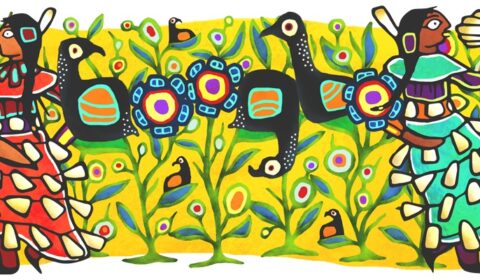SATURDAY’S GOOGLE DOODLE BY PARRY SOUND ARTIST
Mark Clairmont | MuskokaTODAY.com
PARRY SOUND — Saturday, when you did your usual Google search, you may have notice a beautiful Google Doodle of the day.
Well, an Indigenous artist who spends half his year at a First Nation near Parry Sound was the man behind it.
Joshua Mangeship Pawis-Steckley was asked in April to help create an image of the jingle dress dance, popular at North American powwows, according information by Google about each day’s doodle.
According to them, dancers move in unison and “a sound fills the air, like raindrops falling on a tin roof.”

It said: “Today’s Doodle by Ojibwe guest artist Joshua Mangeship Pawis-Steckley celebrates the Jingle Dress Dance, which originated during the 1920s amongst the Ojibwe tribe somewhere between Wisconsin, Minnesota, and Ontario. The dance lives on today, notably in events such as the Mille Lacs Band of Ojibwe Grand Celebration Pow Wow this weekend in Hinckley, Minnesota.”
It says, according to stories passed throughout generations, the origin of the jingle dress dates back to when an Ojibwe girl fell sick, and the idea for the dress and dance came to her worried father through a vision. Hundreds of metal cones, known as ziibaaska’iganan, were fashioned and sewed onto her dress so that the dance movements would create a jingling sound.
The girl’s father taught his daughter the sacred dance, instructing her to always keep one foot on the ground—and eventually, her illness was cured. After the girl recovered, she taught her friends to make the dresses. Together, they created the first Jingle Dress Dance Society.
Over time, the choreography and dress style of the jingle dress has evolved, with increasingly intricate footwork learned through years of practice for the competitive pow wow circuit, as well as garments now ranging from aprons to full-length designs. Many dancers make their own dresses, as taught by parents or tribal elders. Some wear eagle feathers in their hair, or carry a feather fan.
Despite some changes over the years, what remains constant is the dance’s jingling sound. Today, the dance also serves to affirm the power of Native American women.
